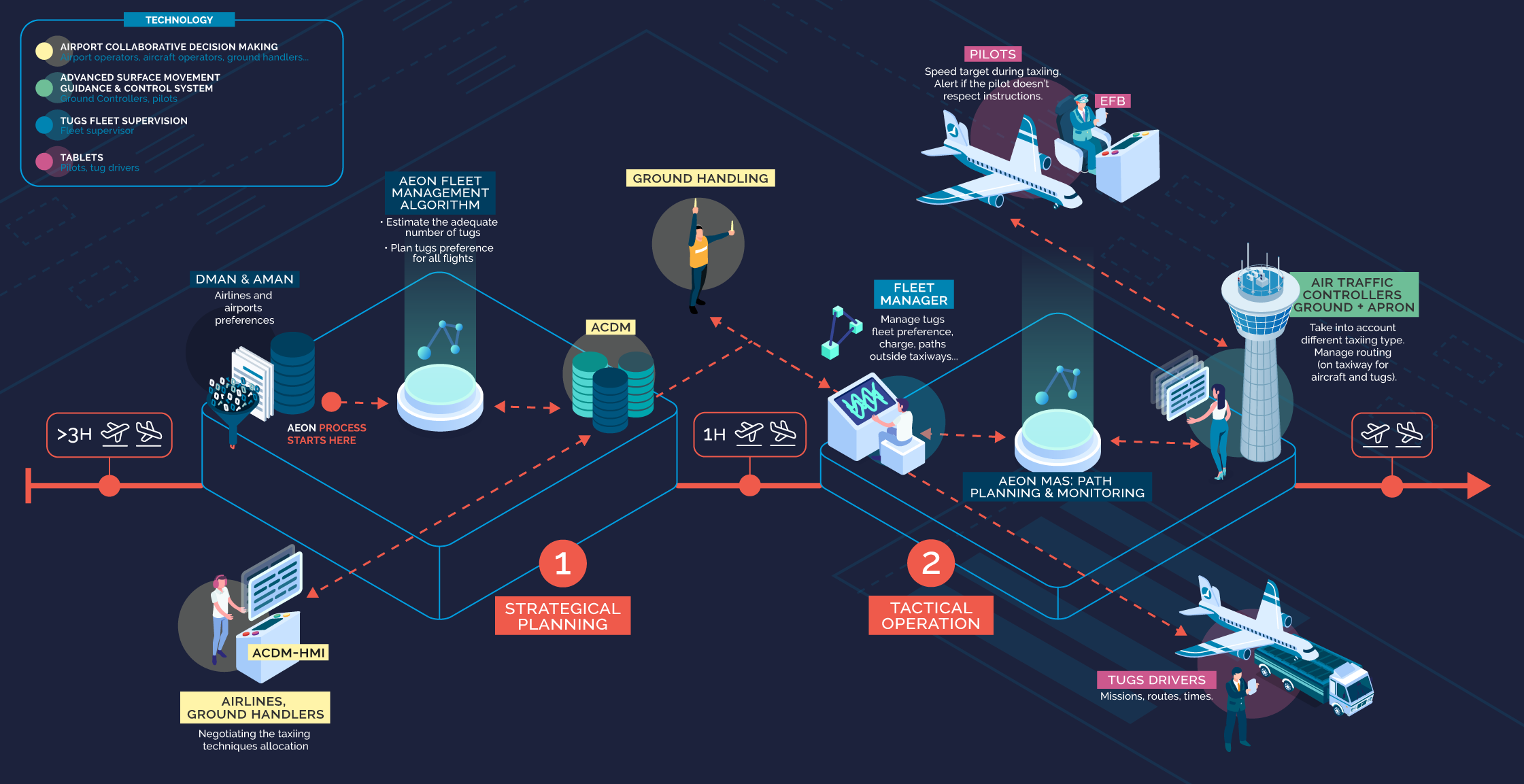A concept for sustainable taxiing operations

The AEON solution proposes a novel operational concept for more sustainable and efficient operations on the ground.
Thanks to the combination of different classes of engine-off techniques, the purpose is to reduce the environmental impact of taxiing operations without affecting capacity, safety, and human performance. The techniques considered involve single-engine taxiing solutions, hybrid towing taxiing solutions and autonomous taxiing solutions based on electric engines.
The operational concept is based on the belief that these taxiing techniques may become robust solutions and technologies in the future and there will be a need for them to coexist in the airport environment and to be used in a coordinated way. By means of a set of dedicated tools and interfaces for the different ground operators, as well as dedicated algorithms, the AEON solution aims at supporting such stakeholders in sharing their constraints to decide together on the best usage of the different available taxiing techniques for each flight, and then manage potential operational events that would prevent the initial plan to deliver correctly.
Considering the above, the AEON solution is planned to influence ground operations at different time phases of the planning, and to involve a variety of different operators both in the strategic planning and execution phases of the procedures.
At the strategic long/medium planning phase, a support tool will help estimate the adequate number of tug vehicles to operate a given airport considering its specific traffic. Then the best allocations of taxiing techniques to each arriving and departing aircraft will be provided considering the arrival and departure sequences plus the operational constraints of the tugs fleet. Then the allocations will be proposed to the different actors through the Airport Collaborative Decision-Making (A-CDM) portal. They will have until one hour before the Target Start-Up Approval Time (TSAT) to freeze the decision to accommodate last-minute operational events.
Afterwards, for the tactical execution phase, AEON provides Human-Machine Interactions (HMIs) for ATC officers and pilots to manage the actual taxiing. Advanced Surface Movement Guidance and Control System (A-SMGCS) HMIs will:
- identify the taxiing techniques of each aircraft,
- help define the taxi clearances, especially for towed departing aircraft that will need to stop for detaching process somewhere without disturbing the rest of the traffic,
- give real-time updates on remaining taxi time to give to the pilot in order to facilitate engines start-up procedure, and
- help reassign non-autonomous taxiing techniques when operational events modify the initial plan.
In addition, the AEON solution considers that the aircraft using electrical engines for taxiing (or towed by tugs) are more easily controlled on speed, i.e., they can take speed targets and follow them. Since the common drawback to all engine-off taxiing techniques is the lower acceleration level, it would be highly beneficial to avoid stop-and-go. AEON thus provide a speed target to avoid aircraft arriving simultaneously at the same intersection, hence smoothing traffic control. Furthermore, AEON will explore the possibility to give speed cues to the pilot through datalink, to be displayed on the electronic flight bag to avoid additional workload and radio frequency usage for ATC. The AEON concept of operations assumes tug vehicles use taxiways both when coupled with an aircraft or when empty. The validation activities show interesting results concerning the use of service roads to relieve congested taxiways and reduce ATCOs’ workload. Service road usage shall be further investigated in future research to quantify the impact on the overall operational concept.
Find out more in D1.2 – Concept of Operations Final Version! …Or check out the results produced by the validation activities on Human Performance and Liability, Safety, and Cost-Benefit.
